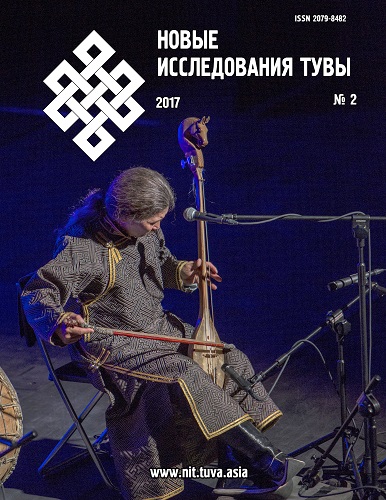От звуков горлового пения к звукам шаманских практик: Структурная организация шаманских ритуалов в Туве
DOI:
https://doi.org/10.25178/nit.2017.2.4Ключевые слова:
Тува; тувинцы; шаман; горловое пение; шаманские практики; шаманские ритуалыАннотация
В данной статье описываются особенности шаманской практики в Республика Тыва (Российская Федерация). В качестве особенностей шаманского ремесла здесь отмечается отсутствие трансовых состояний, в которые могут впадать шаманы и в качестве неотъемлемых элементов шаманского репертуара анализируется значение звука и музыки. Утверждается, что организационная структура акустической системы горлового пения, богатого обертонами, расширяет возможности шаманских ритуалов, представляя более широкие рамки шаблонов мышления и поведения. То есть звуки являются не только неотъемлемой чертой коммуникации шаманов при переговорах с духами, но выступают «аналитической линзой» для более широкого понимания шаманских практик и взаимодействий в рамках социокосмоса в Туве.
Библиографические ссылки
Сузукей, В. Ю. (2007) Тувинская музыка в ХХ веке. М. : Композитор. 408 с.
Сузукей, В. Ю. (2010) Проблемы концептуального единства теории и практики. Кызыл : Тываполиграф. 258 с.
Eliade, M. (1964) Shamanism: Archaic Techniques of Ecstasy. New York. 610 p.
Hodgkinson, T. (2005/2006) Musicians, Carvers, Shamans // The Cambridge Journal of Anthropology, vol. 25, no. 3.
Ingold, T. (2011) Being alive. Essays on knowledge, movement and description. New York: Routledge.
Stoller, P. (1984) Sound in Songhay Cultural Experience // American Ethnologist. Vol. 11. No. 3
Vitebsky, P. (2012) Wild Tungus and the spirits of places // Ab Imperio, no. 2, pp. 429–448.
Опубликован
Как цитировать
Выпуск
Раздел

Автор (лицензиар) произведения предоставляет простую (неисключительную) лицензию на использование редакцией (лицензиатом) произведения науки, который заключается в упрощённом порядке (открытая лицензия), согласно ст. 1286.1. «Открытая лицензия на использование произведения науки, литературы или искусства» Гражданского кодекса Российской Федерации.
В нашем издании публикуемые материалы доступны по лицензии Creative Commons «Attribution-NonCommercial» («Атрибуция — Некоммерческое использование») — CC BY-NC.
Т. к. лицензия открытая, автор имеет право разместить статью после ее выхода на своем сайте, читатель может скопировать и разместить на своих персональных ресурсах, в том числе в виде выдержек, конспектов, но:
а) обязательно должно быть указано ФИО автора, неизмененное название статьи и гиперссылка на первоисточник (журнал «Новые исследования Тувы»),
б) размещающий не имеет права брать деньги за доступ к этому материалу или каким бы то ни было образом давать преимущество одним читателям над другими,
в) при перепечатке автором текста статьи без значительных изменений (если сохраняется 30% текста или более) должно быть указано, что первая редакция статьи вышла в журнале «Новые исследования Тувы» и сделана соответствующая ссылка.
Лицензия действует по всему миру, длится в течение срока авторских прав на произведение, является неотзывной.









